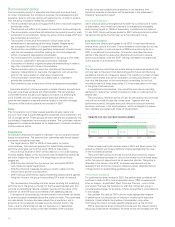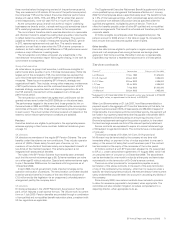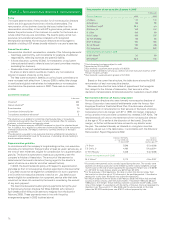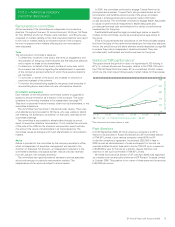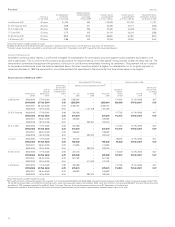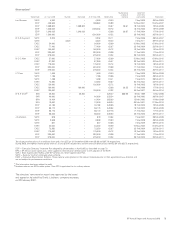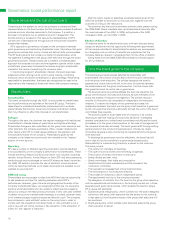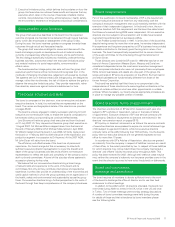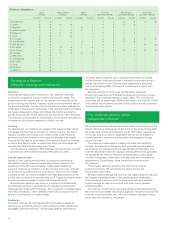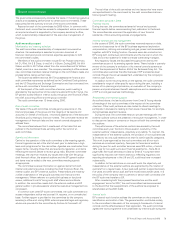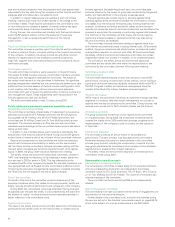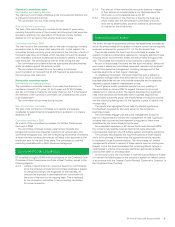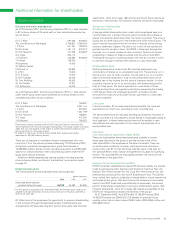BP 2006 Annual Report Download - page 82
Download and view the complete annual report
Please find page 82 of the 2006 BP annual report below. You can navigate through the pages in the report by either clicking on the pages listed below, or by using the keyword search tool below to find specific information within the annual report.80
year and obtained satisfaction that the proposed work plan appropriately
responded to the key risks facing the company and that internal audit had
adequate staff and resources to complete its work.
In addition to regular observations and updates at each committee
meeting, internal audit made two written reports of its findings to the
committee in 2006. These reports contributed to the committee’s view
on how effective the company’s system of internal controls had been
and formed the basis of its recommendations to the board.
During the year, the committee met privately with the head of internal
audit (the BP general auditor), without the presence of executive
management. It also evaluated the performance of the internal
audit function.
Fraud reporting and employee concerns/whistleblowing
The committee received a quarterly report from internal audit on instances
of actual or potential fraud or concerns relating to the financial accounting
of the company. In addition, the group compliance and ethics function
reported on issues raised via the employee concerns programme,
OpenTalk, together with other topics arising from the company’s annual
certification process.
Performance evaluation
The audit committee conducts a yearly evaluation of its performance.
The review for 2006 involved a survey of committee members and other
individuals who had regularly attended the committee. The results of
the review were fed back to the committee in November. No significant
process changes were identified but the committee did determine to take
additional time in private session at the end of each meeting and to hold
a joint meeting with the safety, ethics and environment assurance
committee each year to review the general auditor’s internal controls and
risk management report. These adjustments were incorporated in the
forward agenda and work plan for 2007.
The audit committee plans to meet 12 times during 2007.
Safety, ethics and environment assurance committee report
Membership and meeting schedule
The committee’s members consist solely of independent non-executive
directors and include Dr W E Massey (chairman) and Mr A Burgmans.
During 2006, Mr M H Wilson and Mr H M P Miles retired from the
committee and Sir William Castell and Sir Tom McKillop joined as new
members. The company secretary’s office ensures new committee
members receive briefings on the committee’s tasks and process before
taking up their roles.
In addition to the members above, each meeting is attended by the
lead partner of the external auditors (Ernst & Young) and the BP general
auditor (head of internal audit) at the invitation of the committee chairman.
Reports and presentation to the committee are led by the executive
director with functional accountability for safety and the environment
(Mr Iain Conn) and the committee’s dialogue includes meeting with the
relevant senior managers and functional experts for each of its agenda
topics. In 2006, the group chief executive attended one meeting.
The safety, ethics and environment assurance committee, created in
1997, has increased the frequency of its meetings in recent years from
four per year in 2003 to seven in 2006. This has reflected both the
increased breadth of the company’s business (for example, expansion into
new geographies such as Russia) and the committee’s additional work in
monitoring the executive management’s response to incidents (including
the Texas City fire and explosion and the oil spills in Alaska).
Role of the committee
On behalf of the board, the committee monitors observance of the
executive limitations policy that relates to the environmental, health and
safety, security and ethical performance and compliance of the company.
During 2006, the committee’s name was amended. Having reviewed
its agendas over the past few years, it was considered by the board that
the addition of ‘safety’ to ethics and environment assurance provided a
better reflection of the committee’s work.
Agenda and information
The tasks of the safety, ethics and environment assurance committee are
particularly broad as they cover all non-financial risks. In constructing its
forward agenda at the beginning of each year, the committee pays
particular attention to the review of group risks conducted by the general
auditor and risks identified in the company’s business plans.
Forward agendas also include regular or standing agenda items.
Standing agenda items are those that enable the committee to monitor
and assess how the executive limitations policy is being observed (for
example, compliance and ethics and health, safety and environment
reports) and review the specific non-financial risks that are identified in the
company’s annual plan (for example, in performing regional risk reviews).
The chairman of the committee will also review the forward agenda
against any emerging issues or developments that may arise during
the year and amend as necessary.
The committee receives information relating to agenda items from
both internal and external sources, including internal audit, BP’s external
auditors, the group compliance and ethics function and external market
and reputation research. In common with other BP board committees,
the safety, ethics and environment assurance committee can access
independent advice and counsel if it requires, on an unrestricted basis.
The activities of the safety, ethics and environment assurance
committee and any issues that have arisen are reported back to the
main board by the committee chairman following each meeting.
Committee activities in 2006
HSE performance
The committee received reports on both the company’s overall HSE
performance, including an examination of key metrics, and on individual
topics such as human resources capability, employee health and HSE in
TNK-BP. Progress in safety and operations management since the
incident at the Texas City refinery has been reviewed regularly.
Regional risk reviews
While most of the board-level monitoring is undertaken through business
segments or functions, risks that require management at a country or
regional level are also scrutinized by the committee. During the year, risk
reviews were carried out for North America, Russia and the Caspian.
Compliance and ethics
The group compliance and ethics function reports to the committee
on a quarterly basis. During 2006, the compliance and ethics reports
covered the results of the 2005 certification process, progress on the
implementation of the company’s code of conduct and the operation
of OpenTalk.
Performance evaluation
The committee conducts an annual review of its process and
performance. This year’s review was discussed at the committee’s
November meeting and has led to enhancements in the committee
process going forward, including the incorporation of reports from the
new group operations risk committee and an increase in time allotted to
agenda items to enable further in-depth discussion.
The safety, ethics and environment assurance committee plans to
meet seven times during 2007.
Remuneration committee report
Membership and meeting schedule
The remuneration committee consists solely of non-executive directors,
who are considered by the board to be independent. Committee
members include Dr D S Julius (chairman), Mr J H Bryan, Mr E B Davis,
Jr, Sir Tom McKillop and Sir Ian Prosser. The chairman of the board also
attends meetings of the committee.
The committee met five times during 2006 and is independently
advised.
Role of remuneration committee
The committee’s main task is to determine the terms of engagement and
remuneration of the executive directors.
Further details of the committee’s role, authority and activities during
the year are set out in the directors’ remuneration report on pages 68-75,
which is the subject of a vote by shareholders at the 2007 AGM.


